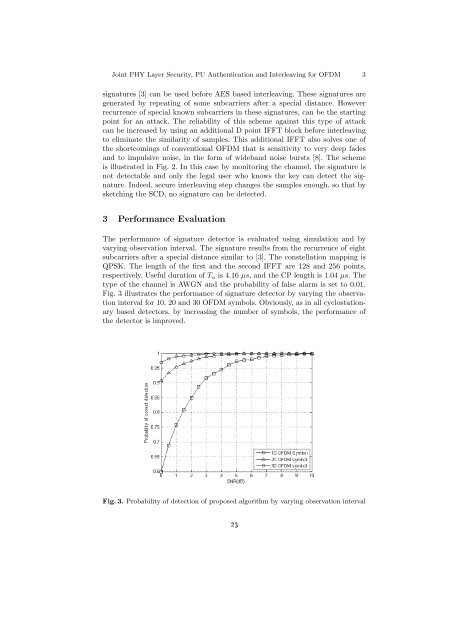MMB & DFT 2012 Workshop Proceedings
MMB & DFT 2012 Workshop Proceedings
MMB & DFT 2012 Workshop Proceedings
You also want an ePaper? Increase the reach of your titles
YUMPU automatically turns print PDFs into web optimized ePapers that Google loves.
Joint PHY Layer Security, PU Authentication and Interleaving for OFDM 3signatures [3] can be used before AES based interleaving. These signatures aregenerated by repeating of some subcarriers after a special distance. Howeverrecurrence of special known subcarriers in these signatures, can be the startingpoint for an attack. The reliability of this scheme against this type of attackcan be increased by using an additional D point IFFT block before interleavingto eliminate the similarity of samples. This additional IFFT also solves one ofthe shortcomings of conventional OFDM that is sensitivity to very deep fadesand to impulsive noise, in the form of wideband noise bursts [8]. The schemeis illustrated in Fig. 2. In this case by monitoring the channel, the signature isnot detectable and only the legal user who knows the key can detect the signature.Indeed, secure interleaving step changes the samples enough, so that bysketching the SCD, no signature can be detected.3 Performance EvaluationThe performance of signature detector is evaluated using simulation and byvarying observation interval. The signature results from the recurrence of eightsubcarriers after a special distance similar to [3]. The constellation mapping isQPSK. The length of the first and the second IFFT are 128 and 256 points,respectively. Useful duration of T u is 4.16 µs, and the CP length is 1.04 µs. Thetype of the channel is AWGN and the probability of false alarm is set to 0.01.Fig. 3 illustrates the performance of signature detector by varying the observationinterval for 10, 20 and 30 OFDM symbols. Obviously, as in all cyclostationarybased detectors, by increasing the number of symbols, the performance ofthe detector is improved.Fig. 3. Probability of detection of proposed algorithm by varying observation interval23


